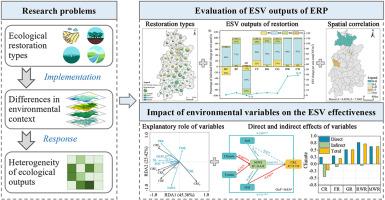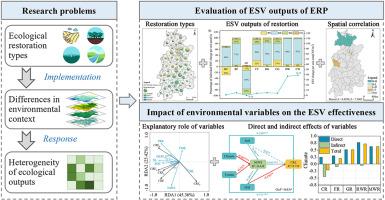Environmental variables affect the effectiveness of ecosystem services of ecological restoration project: Evidence from Xiangjiang River Basin-Dongting Lake
IF 10
1区 环境科学与生态学
Q1 ENGINEERING, ENVIRONMENTAL
引用次数: 0
Abstract
Understanding the ecosystem services effectiveness of ecological restoration project (ERP) and their environmental impact factors is crucial for optimizing restoration strategies. However, current studies still have limitations in terms of the evaluation benchmarks for the ecological effects of ERP and the interaction pathways among the factors influencing those ecological effects. Therefore, this study explored a pilot restoration project of full-array ecosystems in the Xiangjiang River Basin-Dongting Lake area as an example. By using Patch-generating Land Use Simulation and benefit transfer methods, an assessment baseline for the scenario without ERP was established, and the effectiveness of ecosystem service value (ESV) for different restoration types was evaluated. Redundancy analysis and Partial Least Squares Structural Equation Modeling were then employed to decouple the direct and indirect effects of environmental variables on the ESV effectiveness. The main findings indicate that climate, terrain, and human activity intensity were the primary environmental factors influencing the ESV effectiveness. In damaged areas with rich hydrothermal conditions, complex terrain, and strong human activity interference, the direct improvements in ESV after restoration were more obvious. However, the environmental constraints on the recovery of vegetation and water body were also greater, which indirectly weakens the ESV effectiveness. This study provided a comprehensive perspective for understanding the effectiveness of ERP and enriched decision-support methods for ERP.


环境变量对生态修复工程生态系统服务效能的影响——以湘江流域-洞庭湖为例
了解生态恢复项目的生态系统服务效能及其环境影响因子对优化生态恢复策略具有重要意义。然而,目前的研究在ERP生态效应的评价基准和影响这些生态效应的因素之间的相互作用途径方面仍然存在局限性。因此,本研究以湘江流域—洞庭湖地区为例,探索了全阵列生态系统修复试点项目。采用斑块生成土地利用模拟和效益转移方法,建立了无ERP情景下的评估基线,并对不同恢复类型的生态系统服务价值(ESV)有效性进行了评价。然后利用冗余分析和偏最小二乘结构方程模型来解耦环境变量对ESV有效性的直接和间接影响。结果表明,气候、地形和人类活动强度是影响ESV有效性的主要环境因子。在热液条件丰富、地形复杂、人类活动干扰较强的受损地区,恢复后ESV的直接改善更为明显。但植被和水体恢复的环境约束也较大,间接削弱了ESV的有效性。本研究为理解ERP的有效性提供了一个全面的视角,并丰富了ERP的决策支持方法。
本文章由计算机程序翻译,如有差异,请以英文原文为准。
求助全文
约1分钟内获得全文
求助全文
来源期刊

Journal of Cleaner Production
环境科学-工程:环境
CiteScore
20.40
自引率
9.00%
发文量
4720
审稿时长
111 days
期刊介绍:
The Journal of Cleaner Production is an international, transdisciplinary journal that addresses and discusses theoretical and practical Cleaner Production, Environmental, and Sustainability issues. It aims to help societies become more sustainable by focusing on the concept of 'Cleaner Production', which aims at preventing waste production and increasing efficiencies in energy, water, resources, and human capital use. The journal serves as a platform for corporations, governments, education institutions, regions, and societies to engage in discussions and research related to Cleaner Production, environmental, and sustainability practices.
 求助内容:
求助内容: 应助结果提醒方式:
应助结果提醒方式:


